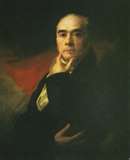Henry Raeburn (1756-1823) was a prominent Scottish portrait painter whose works depicted the elite of Scottish society in the late Georgian period.
Raeburn was born in Stockbridge, Edinburgh, the younger son of a manufacturer. He was orphaned young and raised by an older brother who paid for his education. Apprenticed to a goldsmith at age 15 he soon showed a natural talent for etching and painting miniature portraits on items such as jewellery and mourning-rings. He married a wealthy widow in 1778, which allowed him to concentrate upon his artwork, and though he was self-taught his ability with oil paints was such that his fame spread rapidly.
One of Raeburn's most famous works is popularly known as the Skating Minister. It is believed to show the Reverend Robert Walker skating on Duddingston Loch near Edinburgh. This remarkable composition is not at all typical of his work, but the minister's sober dress and demeanour contrast memorably with both his elegant skill as a skater and the romantic backdrop.
Much more representative of Raeburn's usual work is this portrait of the celebrated novelist Sir Walter Scott in 1822. Sir Joshua Reynolds is one of the many artists who esteemed Raeburns portraiture.
This is the only self-portrait Raeburn is known to have produced, painted around 1820. It features among a number of his portraits commemorated in a set of British postage stamps issued in 1973 to mark the 150th anniversary of his death.
Although he was both famous and celebrated in his lifetime, Raeburn does not seem to have been much of a businessman and he died intestate with £10 in his house and another £16 in his bank account. As the inventory of his estate shows, however, at the time of his death he was owed debts amounting to over £4,500 by his many famous and wealthy clients.



No comments:
Post a Comment